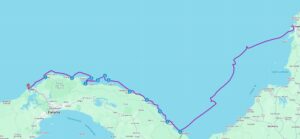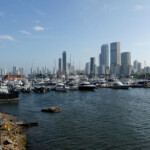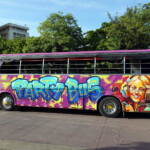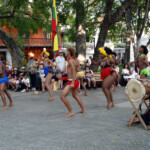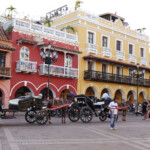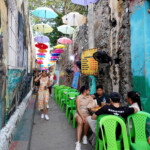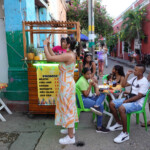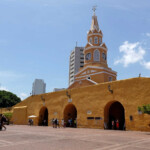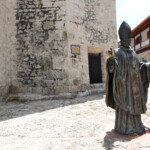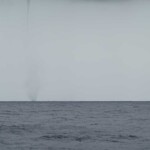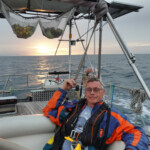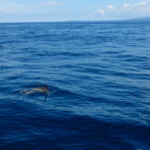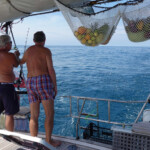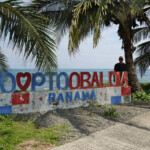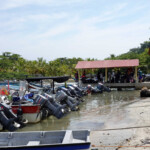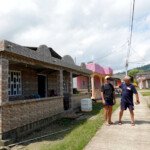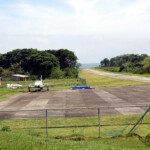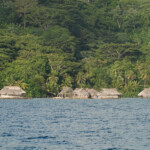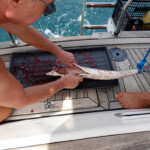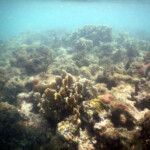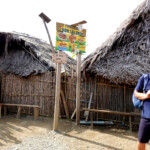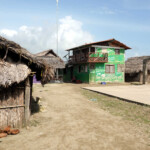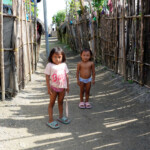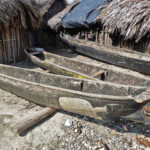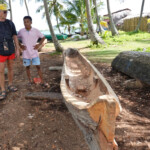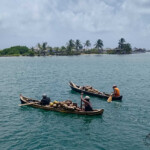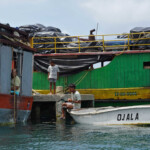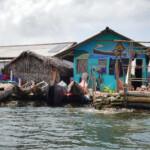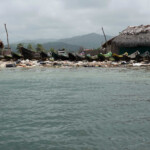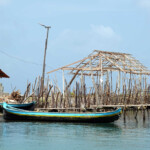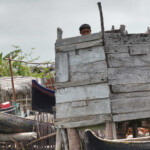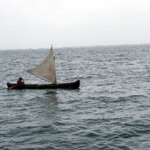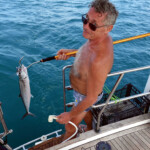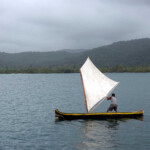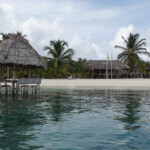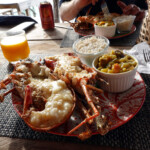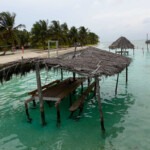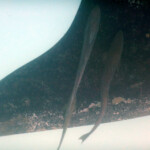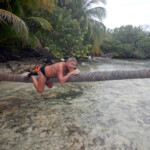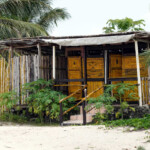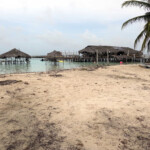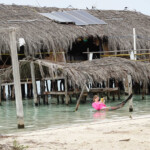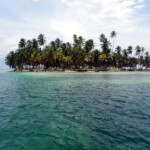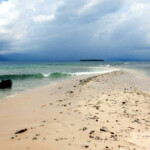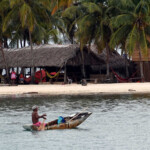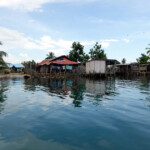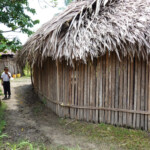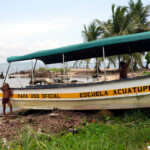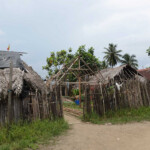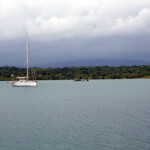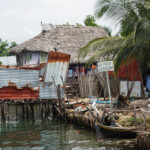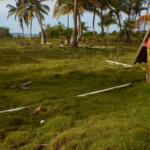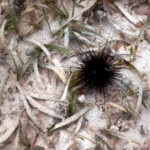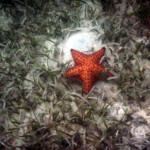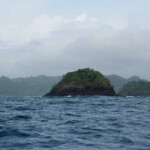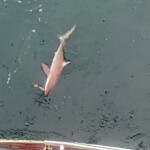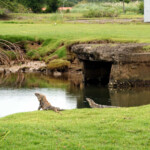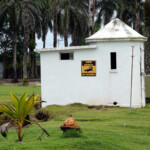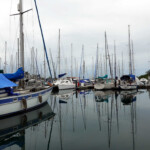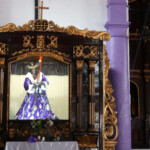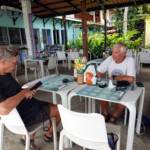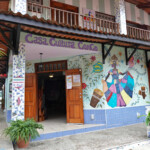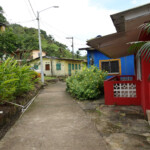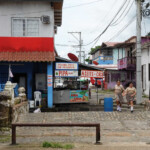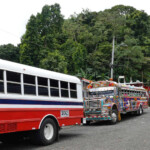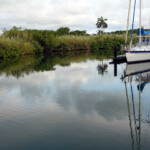Date: July 10-August 6, 2025
Route: Cartagena-Puerto Obaldia-Puerto Escoces-Isla Pinos-Mamitupu-Snug Harbor-Coco Banderas-Benedup-Pugsu-Acuadup-Wailidup-Palmira-Portobelo-Colon
Miles/Hours: 473 NM/109 Hrs
Colombia
Cartagena
Mercado Bazurto
A huge bazaar where you can buy everything: clothes, shoes, electronics, household appliances, fresh fruit and vegetables, all at very affordable prices. For example, pineapples cost 2 or 3 złoty each, 8 large mangoes cost 5 złoty, totaling about 3 złoty on average per kilogram. Colombian Departure Check
An agent is needed for departure checks (just like for arrival checks) – fortunately, they only need to be paid once. In the morning, I drop off my passports at the agency’s office. In the afternoon, our agent calls, revealing that they’d stamped a 15-day visa at the airport when we returned from Poland, and we’d been in Cartagena for 19 days after returning from Poland, so they were about to issue us a fine. But luckily, in Santa Marta, they’d entered 90 days upon arrival, and that was enough. The next morning, we received our passports with stamps and our departure certificate.
The Road to Panama
At Club de Pesca, we fill up with 114 gallons of fuel and set off. We have 170 nautical miles ahead of us. First, we motor across the bay for about an hour, then we hoist the mainsail and genoa, and with 10 knots of wind, we sail for about 5 knots. The day is overcast, but it doesn’t rain. It gets stormy at night, so we start the engine and escape the lightning. After the storm, we get back on track. We sail all Friday. We escape the tornado – it looks spectacular from afar. Another night at sea and again we escape the storms, then we turn off the engine, furl the sails, and with a light breeze on the sprayboard, we’re moving in the right direction. In the morning, we start the engine. We decide to reach the anchorage before dark. We park around 4 p.m. A few more anchor checks, a swim, and then we can go to bed.
Panama
Puerto Obaldia
We stay at anchor all Sunday to check in on Monday – a weekday. There are two piers at the bay. One is suspiciously empty, and the other is lined with boats. From the water, the town looks like a row of shacks. In the evening, we unpack the boat and prepare it for launching. Boarding Check-in
On Monday morning, we sail ashore. First, a police station (or maybe a military one), a concrete “bunker” right next to the jetty – no one speaks English :-(. There we show our passports, and the officer takes a photo of our customs clearance from Cartagena. It takes a while to determine whether we want to enter or leave Panama – but we finally make it. The next point is Immigration, called Migration here, a real office with officials, a scanner, stamps, and a computer. The officer scans our passports and fingerprints, takes photos from a camera connected to the computer, and stamps the entry date. Officially, we can stay in Panama for 90 days, but this can be extended in Panama City to 180 days. We’ll see. The next point is the Port Authority (Maritime Authority). Here we need copies of documents (passports of the entire crew, crew list, yacht registration document) – preferably two copies, but one was also enough. We get ZARPA entry documents, payment documents, a copied crew list, everything stamped. We pay $12 for all the documents (or $15 total, because you’re not supposed to give change). It turns out that 1 Balboa here equals 1 USD. They accept payments in both currencies.
After settling the documents, we go to explore the “town.” From land, it turns out to be much nicer than from the water. Nice, tidy houses, nice people, they even have an airport for small planes, but only one plane lands there every few days (we saw one on Sunday, and the next one was supposed to arrive on Tuesday). There’s a self-service grocery store, a bakery, a hardware store, and a clothing store. The roads are concrete. There are no cars, but there are cargo ATVs, but most people get around on foot. Since 2020, they received a large subsidy, so new roads and bridges are being built. There’s a ferry port, a jetty where fishing boats depart. Passengers have their luggage in plastic bags to keep it from getting wet during the journey. We return to the yacht and a few minutes later At 13:00 we set off towards the San Blas Archipelago.
Puerto Escoces
We sail quite deep into the bay, passing a village of several houses built on stilts in the water – we suspect these are tourist rentals. We sail deeper into the bay and drop anchor in the middle – we’re the only yacht, so we don’t worry about anyone getting too close, or us getting too close to another boat. Around us is only rainforest and silence. We swim and go to sleep.
Isla Pinos
We reach the beach between the reefs and drop anchor about 100 meters from shore. We take turns paddling ashore, visiting the reefs we’ve passed along the way. Marcin goes to a further beach and returns with two coconuts. The beach directly next to the boat is on someone’s property; they’re building a house there, and they come to work in their boats. Around 16:00, a boatload of two “local people” arrives with a full boat. a note with a $10 anchor fee. We pay. The receipt says 10 Balboa, but $10 is also good.
We meet with local “officials” and they charge a fee – $10 for the boat and $2 per person – for a total of $16. We also arrange a trip to a coconut oil “factory” for the next day.
We arrive at the “beach” in our boat. Moments later, our guide arrives – he speaks Spanish and knows only a few words of English. He shows us around the entire village. He shows us the school (children wear uniforms and learn foreign languages) and the council building (meetings are held three times a week – Sundays, Tuesdays, and Fridays). There’s also a ferry port. The entire village has 600 inhabitants. In the morning, the men row their boats ashore. There, they gather coconuts, bananas, and other edible plants, fish, and return to the village in the early afternoon. The women, meanwhile, take care of the children and the house, sew moorings, and some work in the shop or at the school. We visit the coconut oil “factory.” There’s a coconut peeling machine, a copra extractor, and an oil press. You can buy coconut oil for $5 a bottle and coconut soap for $4. The lady turns out to also have a San Blas flag – she leads us to the house and sells it for $10. The house is furnished with a few plastic chairs that double as a wardrobe, a bench, and a few hammocks. There’s a storage room upstairs. Most of the huts in the village are made of bamboo with palm leaf thatch roofs, but there are also brick or plank houses. The journey to get building materials takes five hours each way. You can also take a ferry to the mainland and fly to Panama City for $100. There are numerous airports for small planes on the mainland. At the store, we buy a homemade cookie each for $0.10, which gives me $20 in change. Finally, we visit the “shipyard,” where local cayucos boats are made. They hollow out the center from a single tree trunk (this takes about 3-4 days), then smooth everything out and paint it black – a total of 10 days of work, and the boat will serve its owner for about 10 years. It can be propelled by oars or a homemade sail. The guide receives $10 and we return to the yacht.
After a second breakfast, we take a boat to a nearby uninhabited island. We circle it, collect coconuts, and then sail to see the village from the water. There are two piers at the ferry dock, but only one is in use. Ferries and larger boats dock there. Cottages are built around the lagoon. The “toilets” are small huts at the end of the pier jutting out into the bay. Children use them as defensive structures.
The Kuna Indians are friendly, although they don’t like being photographed – they generally don’t agree to have their photos taken – unlike children, who eagerly await the camera.
The next morning, two Indians bring a “special gift” in a backpack – a beautiful mola with a parrot. It’s supposed to be a gift, but they want $10 for it. I don’t want to buy it, but they’re begging for it. Finally, I give them all the local money – it’s about $5. They grumble, but they don’t want the mola back. Strange people…
Snug Harbor
We arrive in the early afternoon. We stop far from the village, and yet a boat soon arrives offering various goods. We don’t need what they have. Another boat demands a fee for anchoring on their property. They collect a $5 fee, hand-signing something on a piece of paper and claiming they’ll bring the invoice tomorrow. Marcin swims to shore, and another boat arrives, and this one has the toll receipts – he believes we’ve already paid $5, so he takes the remaining $5 and writes out the receipt for $10. He gives us 10 meters of rope. We decide not to pay anything without the receipt from now on. Marcin returns, and we sail to a nearby reef. It’s beautiful, although the water is a bit murky.
Coco Banderas
We sail along the barrier reef and stand at 15 meters, surrounded on three sides by reef.
The next day involves laundry, snorkeling, and exploring the surrounding islands. We buy a bunch of bananas from Kun for $5.
Benedup (Cayos Holandes)
We park on the southern side of Benedup Island, opposite the bar. Marcin swims ashore. After he returns, we launch the boat and sail around the island to the Ibana restaurant. On the way, we stop for Happy Hour at Łukasz’s, who’s been here for a month and a half. Everyone knows him at the bar.
There are plenty of boats at the Swimming Pool anchorage, but the water is beautifully clear.
At the restaurant, we order lobsters, savitches, and for dessert, a coconut cake – a set price of $25. We also order coconut rolls for tomorrow (4 for $1) and head back to the yacht.
In the morning, after breakfast, the boys go get the rolls we ordered, and we have a second breakfast. The weather is poor, a bit rainy and overcast, so we cancel the trip. Instead, Marcin goes to the bar while we do various things on the yacht. In the afternoon, we visit Łukasz on the yacht.
The next day, the weather improves, so we sail to the channel near Calubir Island and see the beautiful reefs and spot a spotted stingray. The next day, Marcin and Łukasz go shark-watching, and we go to a nearby reef. We meet at Iban’s restaurant and have lunch there. We stay for dinner (the guys order pizza, I order fish), and in the evening there’s a bonfire for the backpackers. We return to the yacht in the dark.
Every Friday, the “shop” arrives at Iban’s restaurant, and it has a lot of products. Groceries, both vegetables and fruit, as well as some canned goods and alcohol. You can arrange this in advance and he’ll bring you what you need. Be careful, as the seller makes mistakes in both addition and multiplication.
Pugsu (Tuborgana Salar)
We enter the lagoon through the southern entrance. Most of the channel is a dozen meters wide, but you also have to navigate through 5-meter shallows. We stop on the southern side of the island at 7 meters. The water is clear, although there’s a lot of garbage floating in it.
The next day, we launch the boat and set off to explore the lagoon. We land on two deserted islands – just palm trees and sand, and a few plastic bottles 🙁 .
The next day we explore Pugsu Island – the island has a bar, a hotel, bathrooms, showers, a jetty for the “lancer,” and a beach. The “resort” is powered by solar panels placed on stilts in the water. The beach is raked several times a day, and what they rake is thrown into the water. The other half of the island is uninhabited and already has a lot of garbage. There’s a reef near the island and a place where stingrays feed.
Acuadup
We drop anchor near the village, but a local Kuna comes and says there’s a water supply nearby. Although we didn’t hit the anchor, we decide to move. We eat lunch, view the village from the water, and wait out the next storms.
The next day we launch our boat, mount the engine, and set off on a trip around the island. It’s deep on the south side, but on the north side It’s getting very shallow, so we raise the engine and row. We moor to the mission pier – it was built by Russians and Ukrainians. Free English lessons, meetings, and training sessions are held there. We meet a young man who speaks English – he’s the chief’s son. He shows us around the island (he gets $10 for this). He tells us about the island’s history – it used to be much larger and had many palm trees. Now the water has taken over part of the island. There are a few shops on the island, but we buy orange coconuts and breadfruit from local “growers.” Walking around the village, the boy says, “This is my aunt, this is my cousin, or at least my schoolmates.” He swims to the mainland to go to school. There’s also a school in the village (mornings and afternoons), but for younger children.
Wailidup – Lemon Cays
We approach the anchorage in the Lemon Cays islet complex. It rains the entire way, but as we arrive, the sun comes out. We stop at Wailidup islet. After anchoring, we swim to the islet wearing masks. Along the way, there are starfish, small fish, and lots of pretty plants. There are two resorts on the islet – rather empty – it’s off-season, although boats with customers for the bars arrive. There are cottages, volleyball courts, and solar panels – generally, the resorts are a bit run-down. The island has a water problem – they have tanks, but they fill them with water brought from the mainland. Boats come to us offering various goods: vegetables and fruit, lobsters, octopus, and garbage disposal (they then burn them on the island). At night, we discover that midges are marauding around – in the morning, we’re all very bitten. These small rodents are getting through the holes in the window screens.
The next day, we swim to another island, but this time the resort is in total ruins and empty. On the bottom, we encounter more starfish (one has four arms) and we also see a huge stingray (with a “wingspan” of about 2 meters) with sticks attached to it, various colorful fish and crabs.
Palmira
We set off towards Colon. We set off at 6:30 AM, having breakfast en route. We reach the anchorage around 12:30 PM. There’s a small town nearby – for the first time in three weeks, we’ve seen a car on shore. We stop at 5.5 meters. Marcin swims ashore and brings back two cans of fish and cookies from the shop.
Portobelo
We stop in the bay near Portobelo on the northern shore of the bay. We stop at 6-7 meters. Next to us is a yacht with a Polish flag, but it turns out they’re Brazilian, and the guy is from Belgium. During the night, we’re awakened by another storm and a 180-degree wind shift. Fortunately, the anchor holds well. We stop opposite the fort – we decide to visit it from land. It’s raining in the morning, so we eat breakfast first and then set sail.
Colon
Shelter Bay Marina
Nice marina Before entering the canal, they immediately sent an email with a description of the approach, a marina map, and information about check-in, documents, and events.
The marina has a swimming pool, restaurant, mini market, and barbecue area. There’s also a hotel, library, laundry, and lovely air-conditioned bathrooms. Various WhatsApp groups and social events are thriving: BBQ on Sundays, yoga in the morning (6:30 AM), Karaoke on Fridays, and dominoes on Sundays.
The marina is on a military base, and you have to get through a gate with guards and weapons. The military base is a relic of the US Army, largely neglected and dilapidated, with ruins of old buildings, but a few buildings are still in use and in good condition.
There are crocodiles swimming in the marina pool, and there are signs everywhere advising not to enter the water :-).
Twice daily, at 8:00 AM and 1:00 PM, a bus runs from the marina to the shop (but can also take you to other locations). (E.g., in Colon) costs $1.50 one-way per person.
Portobello by Land
Buses run to Portobelo from the main bus terminal. These are old school buses painted in colorful colors. Inside, music is blaring, and the windows are open, but that’s the only air conditioning. A one-way ride to Portobelo costs $1.60 per person. The bus takes about 1 hour and 45 minutes, with several stops along the way. It runs every hour. It leaves Portobelo 30 minutes after the hour (usually a little later).
Portobello is a pretty town, a UNESCO World Heritage Site. It has a few forts and old houses, a church with a statue of a black Jesus, but overall, everything looks rather poor. We go for a very tasty lunch at Casa Congo, next to the Congo Cultural Center. We return by bus with the children graduating from school – they have a great time because we’re the only white people on the bus. We get off at the stop near the shopping center and take a bus to the marina.



